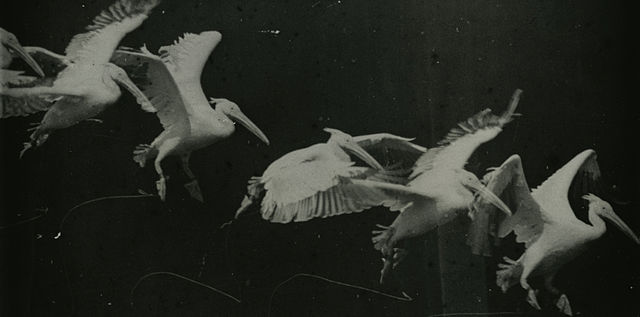
Étienne-Jules Marey, born 5 March 1830, in Beaune, was a French scientist, physiologist and chronophotographer.
To study the flight of birds, he invented a camera in 1882 with magazine plates that recorded a series of photographs; the pictures could be combined to represent movements. In 1894 he adapted the motion-picture camera to the microscope.
His work was significant in the development of cardiology, physical instrumentation, aviation, cinematography and the science of laboratory photography. He is widely considered to be a pioneer of photography and an influential pioneer of the history of cinema.
Marey’s chronophotographic gun was made in 1882, this instrument was capable of taking 12 consecutive frames a second, with all the frames recorded on the same picture. Using these pictures he studied horses, birds, dogs, sheep, donkeys, elephants, fish, microscopic creatures, molluscs, insects, reptiles, etc. Some call it Marey’s “animated zoo”. Marey also conducted the famous study about cats always landing on their feet. He conducted very similar studies with a chicken and a dog and found that they could do almost the same.
Although Marey was a man of science, one cannot ignore his profound contribution to photography.

Image Analysis
I have chosen this photograph of Étienne-Jules Marey to anaylse because I like the effect of sequencing and want to incorporate it within my project in a way. This photograph is extremely old and the outcome and effects on the photograph are not intentional but a product of the time and camera, but I like the contrast of blacks and whites/creams and the almost border that is created by the white circle surrounding the two people, the focal point of the photograph. The blur adds an interesting abstract effect to the photograph. In conclusion this photograph is complex and interesting and has factors that I hope to photograph and include in my own project.

Eve you need to get up to speed with showing more evidence of research and responses to photo-assignments on Everyday and Repetition
See planner below for weeks one and two
14 – 24 Feb + H-term
Research 1: Gather as many visual inspirations as possible that may help you to develop your response to the exam theme. Look at a range of visual material – photographs, films, paintings, drawings, design etc that provide some inspiration for you in the way you want to develop your idea. Make a
mood-board and a mind-map and produce at least 4-5 blog posts that illustrate your thinking and understanding. Use pictures and annotation and make at least one photographic response to initial research over H-term!
25 Feb –3 March
Research 2: Research, at least, the work of two or more photographers/artists; analyse their work with references to texts/ sources/ quotes and explain why you have chosen them and how it relates to your idea and the exam theme. Produce at least 2 blog posts for each artist reference that illustrate your thinking and understanding. Use pictures and annotation and
make a photographic response to your research.
Photo-assignments
Produce a number of quick photoshoots or video shoots using your mobile phone or camera . These initial recordings are testing out ideas that you could develop and refine later on as part of your exam project.
MUST – Choose 1 Task – (C-grades)
SHOULD – Explore 2 Tasks – (B-grades)
COULD – Complete all 3 Tasks – (A-grades)
Everyday
Repition
Play
Narrative
Over half-term you must all do Photo-assignment 1: Everyday and choose a second task of your choice